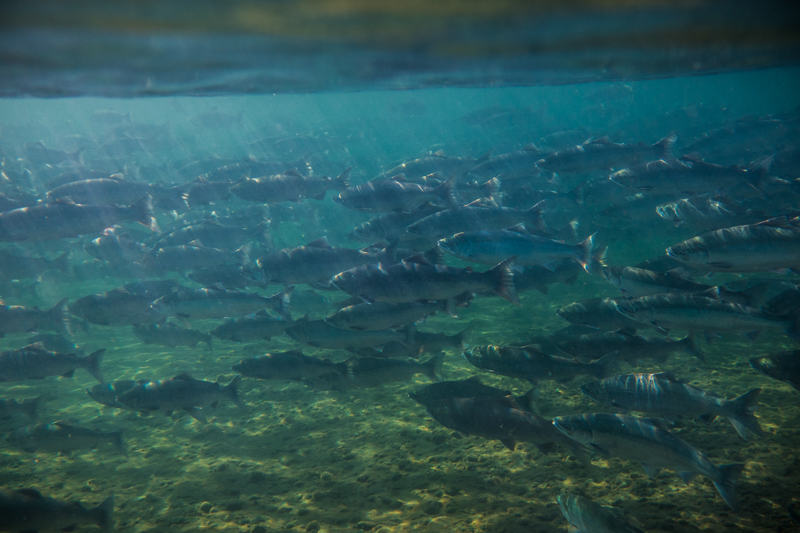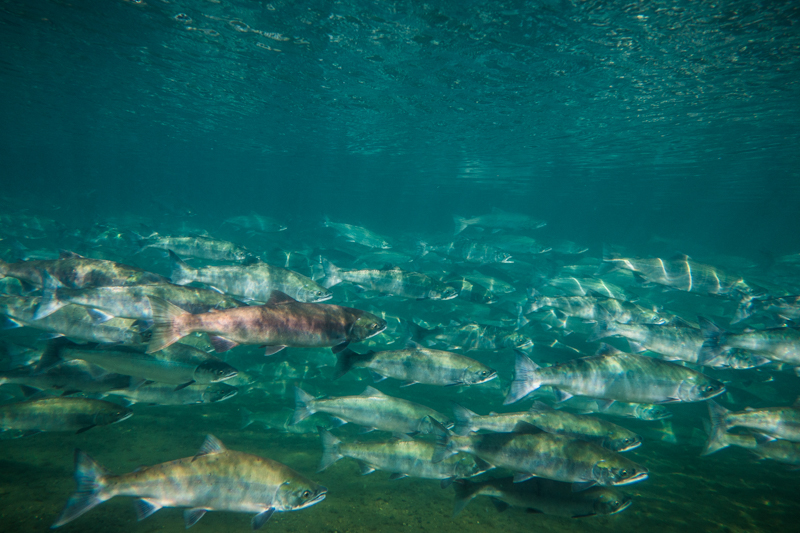 A school of sockeye salmon enter the Brooks River. Photo courtesy of D. Lombardi.
A school of sockeye salmon enter the Brooks River. Photo courtesy of D. Lombardi.
Bears are hungry and big. When they’re not stuffing their gullets, they are working on stuffing their gullets, thinking about how to stuff their gullets, or possibly dreaming about stuffing their gullets. So the bears here are fortunate that the Alaska Peninsula’s greatest resource is sockeye salmon. The largest run in the world happens here. With the 2016 forecast for the entire Bristol Bay region slated to reach 46.55 million sockeye, let’s take a look at how the fishery is managed to create a balance between fulfilling human needs and making sure the bears get fat.
First, the Alaska Department of Fish and Game develops an estimate based on prior years and aimed at the nine major river systems of Bristol Bay, including some major watersheds of Katmai National Park & Preserve: Naknek, Alagnak, and Kvichak rivers. Fisheries biologists use escapement (estimate of salmon literally escaping commercial fishing en route to spawning grounds) and return (total number of salmon attempting to return to spawning grounds) numbers from 1972-2011 to create the initial estimate. They then examine deviations between prior forecasts and actual run numbers to create a confidence interval, which guides the range of expectation. The biologists also examine previous numbers from the nine specific river systems to create individual estimates for each.
The total return estimate for the Naknek river system, the main Katmai system and the one that feeds Brooks River (and eventually the bears), is 4.76 million. A large proportion of which, 3.18 million, is expected to be harvested by the fishery. That leaves 1.4 million expected sockeye for escapement*. These are the fish that have the potential honor of being skinned alive by our resident brown bears.
Recent escapement estimates are reaching the Naknek river goal of 1.4 million fish. The National Park Service estimates 20% of the Naknek River salmon come through Brooks River, meaning more than 280,000 salmon will have come through Brooks River by the time the run finishes. The most recent Brooks River index for brown bears listed 49 bears in 2015. Assuming a similar number this year means each Brooks bear (excluding cubs) can have 5,714 salmon – if they are excellent fishermen… and can teleport… and take zero time to eat.
That is a ludicrous number of salmon. That means each bear could eat 190 salmon every single day throughout July. That’s over 1 million calories daily. Despite 480 giving it his best shot (~40 salmon in 7 hours a few days ago), that does not happen. With NOAA listing average weight of sockeye at 8 lbs., the daily brown bear intake would equal 1,520 lbs. of fish, about the size of the largest brown bears ever recorded. That would be analogous to each bear eating a 747-sized fish cake with a side of sub-adult sized fish cake every day throughout July.
 Bear 747 eats a salmon in the "jacuzzi." Photo courtesy of A. Ramos.
Bear 747 eats a salmon in the "jacuzzi." Photo courtesy of A. Ramos.
Another limiting factor is the salmon run is not constant in terms of density. Each day has a different return, which means each day has a different escapement. The large spurts of fish can happen in a few days. 2016 has seen at least 3 days with Naknek River escapement at 100,000 sockeye. Generally, that translates to 20% of the fish making it to Brooks River two days later. There’s obviously no way ~50 bears can catch 20,000 salmon in a day. This dilemma is part of what facilitates the bears’ use of spawned out salmon in September. The fish that were able to make it past the furry gauntlet at the falls still end up dying and floating out with the current, giving the bears another chance while also giving Brooks Camp its unmistakable fall aroma.
If we take a step back for a larger look at the total escapement for Katmai’s watersheds, we’ll find that 23.17 million salmon are expected to return with 10.61 million anticipated escapement (although the current numbers are not on pace). If we compare that number to Katmai’s most recent brown bear population estimate of 2,183 bears, each individual could get 4,860 salmon. However, the Kvichak watershed is not contained within Katmai and has the largest projected escapement for the three river systems. Most of those salmon will not end up in Katmai. So the resource density is noticeably lower for the bears outside of Brooks River, demonstrating why it is such a great spot for bears to pack on the pounds.
In sum, we “feed the bears” by limiting the commercial catch of sockeye. While the proportion of human harvest is greater, the escapement is a substantial amount of fish that results in high densities of brown bears and full bellies. As much fun as it would be for the rangers to sling salmon to bears like hot dogs at a baseball game, we leave it to the fisheries and associate biologists to facilitate natural runs.
*180,000 Bristol Bay sockeye are expected to be caught in the South Peninsula fishery, limiting Naknek escapements slightly

